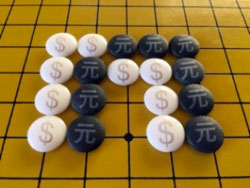|
|||
China’s Global Gold Supply "Game of Stones"David H. Smith China has a 4-way global gold supply domination strategy. And it’s starting to corner the market. First, China buys physical gold in world markets, fabricates it where necessary into “good delivery” bars – in Switzerland or the Middle East – then ships the bullion, transparently through Hong Kong or Shanghai (or quietly through Beijing and other ports of entry). Second, it keeps virtually all domestically mined gold “in house.” Third, China partners with or buys high grade, in-situ gold (and silver) projects around the globe. One of the most well-known recent actions has involved negotiations to partner with Barrick Gold on its massive cost-overrun-plagued Pascua Lama project, which straddles the Chilean-Argentine border. When this event takes place, it will become evident to the world’s financial players that, as Rickards so poignantly remarks, China’s true gold reserves will have become “a dagger pointed at the heart of the dollar.” Most Westerners fail to appreciate the methodology by which China has traditionally pursued – and often successfully achieved – its geopolitical ends.
China’s strategies are oriented from the perspective of many years or even decades, unlike Western governments, who often judge success or failure based upon quarterly or annual progress reports. They are not likely to be concerned if the Pascua Lama project is not in production 10 years from now. They know that the gold – and silver is in the ground, so it’s just a question of when – not if – they can acquire a substantial amount, adding it to their continually-growing stash. China Is “Surrounding” the Global Gold Supply In the figure above, a situation known as “seki” or “mutual life” has taken place. The player with the black stones – labeled here as the Chinese currency, the Yuan, has positioned in such a way that if its opponent moves first – in this case, the U.S. dollar, he will be captured. This Go board move offers an excellent analogy for the U.S. dollar competition with the Chinese Yuan. In order to be “dethroned,” the dollar does not have to be eliminated from global currency completion. It may not be necessary for China – using chess terminology – to fully checkmate the dollar. Instead, simply relegating it to “first among equals” might be enough to effectively cripple its historic full-spectrum functionality, because at that point, the Federal Reserve would no longer have the ability to issue unlimited, un-backed, U.S. dollar-denominated debt instruments. A Game of Stones and Silk “Surrounding” global gold production is just one aspect of China’s grand strategy for achieving political and economic dominance in Central Asia and beyond. The revitalization of modern-day trade routes, throughout direct spheres of influence, integrated with connections into Europe – once known as The Silk Road – is well underway. Think of this term as a plural. These “roads” will see Chinese companies investing along their paths in dozens of countries, a significance that is almost impossible to overestimate. Pepe Escobar, the roving correspondent for Asia Times/Hong Kong, describes it this way: The Yiwu-Madrid route across Eurasia represents the beginning of a set of game-changing developments. It will be an efficient logistics channel of incredible length. It will represent geopolitics with a human touch, knitting together small traders and huge markets across a vast landmass. It’s already a graphic example of Eurasian integration on the go. And most of all, it’s the first building block on China’s ‘New Silk Road,’ conceivably the project of the new century and undoubtedly the greatest trade story in the world for the next decade. The progression of China’s Go game strategy – and rising affluence among Asian nations which enables them to buy increasing amounts of gold and silver – are all positive factors supporting higher precious metals prices. When push finally comes to shove, David Galland of Casey Research seems to have nailed it when he said, “The dollar is headed toward the sacrificial altar, with a knife made of gold. Sooner or later, the central bankers will have to throw in the towel, and just let gold run.” When that happens, the only question – other than trying to find some metal to buy – will be “How high is high?” Having enough gold and silver within arms’ reach before then may be one of the best decisions you can make. ### David H. Smith David Smith is Senior Analyst for TheMorganReport.com and is a regular contributor to MoneyMetals.com. For the last 15 years, he has investigated precious metals mines and exploration sites all over Argentina, Chile, Mexico, China, Canada, and the U.S. and shared his findings and investment wisdom with readers, radio listeners, and audiences at North American investment conferences. |

